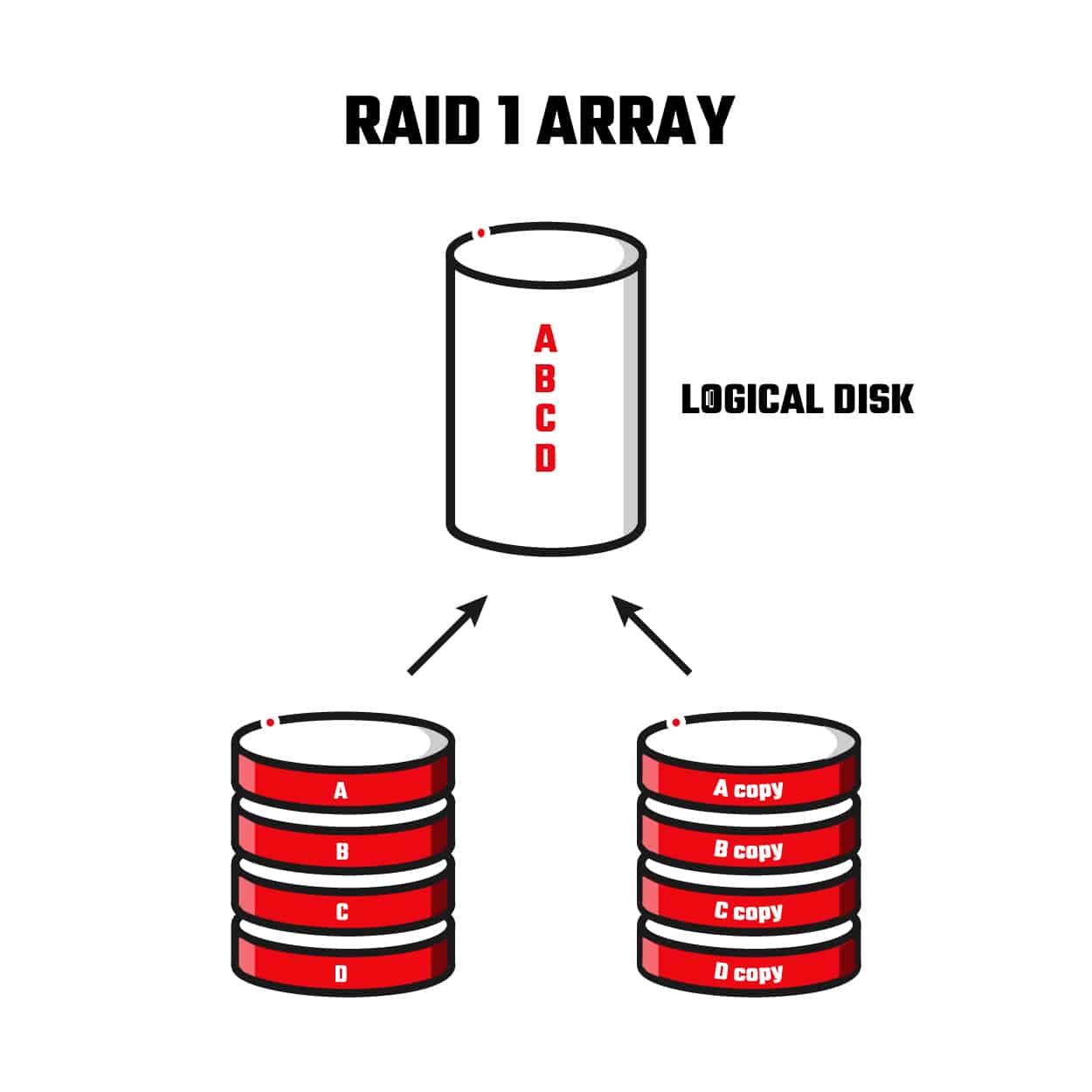RAID 1 Data Storage
Standard RAID (redundant array of independent disks) levels comprise a basic set of RAID configurations that employ either striping, mirroring, or parity to create large reliable data stores from multiple general-purpose computer hard disk drives (HDDs).
RAID 1 offers a bit more data security than RAID 0 because it utilises mirroring (or replicating) data from one disk to another. This at least provides this RAID configuration a measure of redundancy, assuming the failed drive is replaced immediately.

A classic RAID 1 configuration consists of an exact copy (or mirror) of a set of data on two disks. This configuration offers no parity, striping, or spanning of disk space across multiple disks, since the data is mirrored on all disks belonging to the array. This layout is useful when read performance or reliability is more important than write performance or the resulting data storage capacity.
RAID 1 is “effectively” fail-safe since a complete copy of the data is mirrored on the other drive in the array. If one disk fails, here is no complete loss of data. This assume that the failed disk is replaced prior to failure of the disk that is operational.
RAID 1 Failures
Because RAID 1 configurations have, essentially, 2 exact copy drives, there is some protection against and recovery from hardware defects or defective sectors/read errors (hard errors). It does not provide any protection against data loss due to catastrophic failures (fire, water), multiple disc failures, user error, software malfunction, or malware infection. For valuable data – it cannot replace a backup plan.
RAID 1 HARDWARE FAILURES
- Corrupted RAID 1 configuration
- Lightning, flood or fire damage
- Drive physical abuse
- RAID 1 hard disk drive (HDD) overheat
- Intermittent drive failure
- Media surface contamination
- Multiple drive failure
- Power spike
- Power supply burnout or failure
- RAID 1 controller failure
- RAID 1 corruption
- RAID 1 drive incompatibility
- RAID 1 array failed
- Vibration damage
- Damaged connector
- Manufacturer defect
- Power circuit malfunction
HUMAN ERROR
- Unintended or accidental deletion of files or records
- Reformatting of drives/array
- Reformatting of partitions
- Incorrect replacement of media components
- Mistakenly overwritten database files
- Employee sabotage
- Lost/forgotten password
- Overwritten files
- Overwritten RAID 1 config files
- Overwritten RAID 1 settings
- RAID 1 incorrect setup
- RAID 1 user error
RAID 1 SOFTWARE ISSUES
- Backup failures
- Computer virus or worm
- Corrupt files/data
- Damaged files or folders
- Directory corruption
- Firmware corruption
- Re-partition
- Server registry configuration error
- Missing partitions
- RAID 1 configuration error
- Reformatting
APPLICATION FAILURE
- Applications that are unable to run or load files
- Corrupted database data or other files
- Locked databases preventing access
- Deleted tables
RAID 1 Data Recovery
In the event of a RAID 1 failure resulting in data loss, you can try to run some RAID 1 data recovery software. However, even the best RAID 1 recovery programs cannot fix most problems that cause RAID 1 data loss in the first place. Data recovery software isn’t likely to help in severe cases. DIY data recovery utilities can even make things worse and virtually impossible for even the best RAID 0 data recovery companies.
Our advise is simple. If you have encountered a RAID 1 failure resulting in potential data loss, give DriveSavers a call. Raid 1 data recovery is what we do! We are experts in the field with an extraordinary success rate backed by over 40 years as the leader in data recovery.
RAID 1 Data Recovery Experts

Our certified RAID 1 data recovery engineers have the in-depth knowledge and technical expertise that comes from over 40 years of data recovery experience, allowing us to achieve the highest success rate in the industry. DriveSavers Enterprise Systems Group specializes in recovering data from all operating systems and all types of high-capacity devices including redundant arrays of independent disks (RAID), network attached storage (NAS), storage area networks (SAN) and multi-disk servers. We routinely rescue lost databases, ERP accounting systems, mail servers and other mission-critical data for organisations of all sizes.

Because RAID devices are constructed with unique components and configurations depending on the manufacturer, it is imperative that our data recovery engineers have in-depth knowledge of the various proprietary metadata structures and hardware.
Technical alliances with RAID controller manufacturers have enabled our engineers to develop proprietary techniques, tools and technologies that aid in data recovery from RAID devices based on solid-state drives (SSDs), hard disk drives (HDDs) and more complex hybrid and tiered storage environments. All major Raid 1 manufacturers authorize our data recovery services so working with DriveSavers will not void your original warranty.

Extreme damage and data loss can result if any particulate matter enters an HDD. DriveSavers Certified ISO Class 5 Cleanroom is the most advanced data recovery Cleanroom in the industry. This dust-free, static-free, temperature– and humidity-controlled environment maximizes our data recovery successes on all storage devices by protecting the platters and electronic components on the drives from “killer particles” while they are open and vulnerable to damage.
RAID SERVER MAKES & MEDIA
- All HP ProLiant, LeftHand and 3PAR Series
- All Dell PowerEdge, PowerVault, EqualLogic, and Compellent Series
- IBM xSeries, Power Series (AIX, Linux) and storage subsystems
- Supermicro server and storage subsystems
- All Intel and AMD product lines
- SAN– and NAS-based RAIDs and standalone storage systems
- EMC and NetApp product lines


